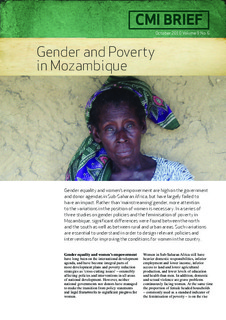| dc.contributor.author | Tvedten, Inge | |
| dc.date.accessioned | 2018-01-04T08:23:57Z | |
| dc.date.available | 2018-01-04T08:23:57Z | |
| dc.date.issued | 2010-10-01 | |
| dc.identifier | oai:www.cmi.no:3812 | |
| dc.identifier.citation | Bergen: Chr. Michelsen Institute (CMI Brief vol. 9 no. 6) 4 p. | |
| dc.identifier.issn | 0809-6732 | |
| dc.identifier.uri | http://hdl.handle.net/11250/2475468 | |
| dc.description.abstract | Gender equality and women’s empowerment are high on the government and donor agendas in Sub-Saharan Africa, but have largely failed to have an impact. Rather than ‘mainstreaming’ gender, more attention to the variations in the position of women is necessary.
In a series of three studies on gender policies and the feminisation of poverty in Mozambique, significant differences were found between the north and the south as well as between rural and urban areas. Such variations are essential to understand in order to design relevant policies and interventions for improving the conditions for women in the country. | |
| dc.language.iso | eng | |
| dc.publisher | Chr. Michelsen Institute | |
| dc.relation | CMI Brief | |
| dc.relation | 6 | |
| dc.relation.ispartof | CMI Brief | |
| dc.relation.ispartofseries | CMI Brief vol. 9 no. 6 | |
| dc.relation.uri | https://www.cmi.no/publications/3812-gender-and-poverty-in-mozambique | |
| dc.subject | Mozambique | |
| dc.subject | Gender | |
| dc.subject | Poverty | |
| dc.title | Gender and poverty in Mozambique | |
| dc.type | Report | |
